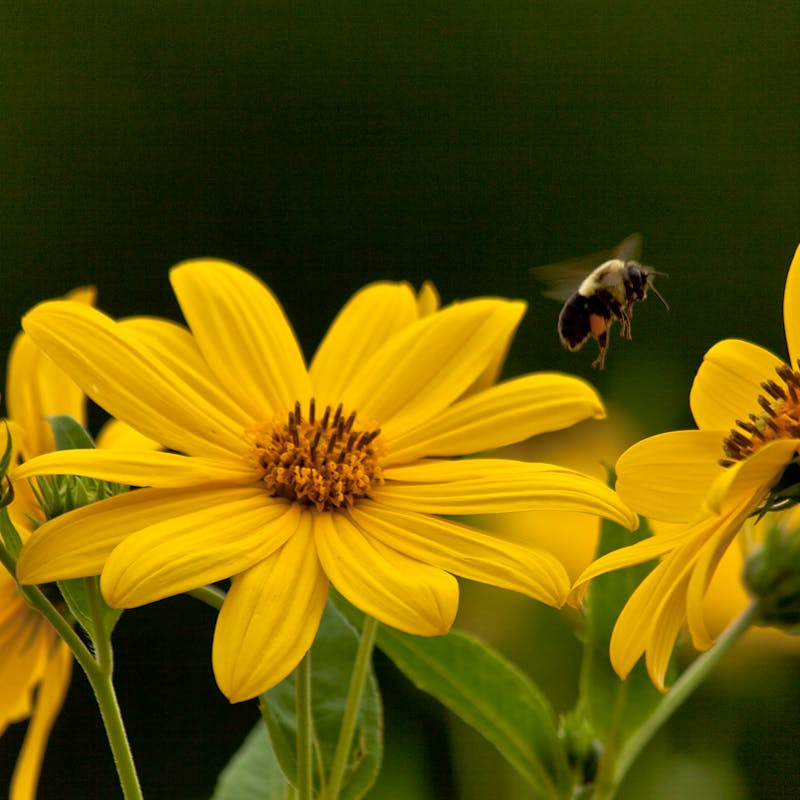Join our mobile Rapid Response Network!
You can be the first to hear about how we’re going to hold this administration accountable and how you can fight back for wildlife!
Pollinators are animals such as bees, butterflies, bats and birds that carry pollen from flower to flower, fertilizing both wild and cultivated plants to produce seeds and fruit.
They are essential to maintaining ecosystems across the nation and around the world. Pollination sustains plants that provide food and shelter for people and wildlife, medicines for people and animals, and diverse and healthy landscapes, from forests to deserts. About one in three bites of food we eat depends on pollinators, and native bees alone provide over $5 billion in crop pollination services every year in the U.S.
Unfortunately, too many native pollinator populations are in decline. The iconic monarch butterfly is currently under consideration for listing under the Endangered Species Act and the focus of a new multi-state plan for improving its conservation. Bumble bees are also declining nationwide, and in 2017 the rusty patched bumble bee was listed as federally endangered.
Habitat loss and fragmentation, pesticides, diseases and viruses are devastating pollinator species from across the animal kingdom. Climate change is a factor in pollinator declines, with shifting temperature and precipitation patterns altering the distribution of plants and their flowering times. Colony collapse disorder in bees is thought to occur because of the confounding of all these factors.

Defenders' Impact
Defenders worked to ensure that Congress passed a strong 2018 Farm Bill that maintained conservation funding, programs and provisions that benefit both landowners and wildlife — including pollinators — while preserving existing environmental laws. Now, we are working with the federal agencies charged with administering the new Farm Bill, including the USDA Natural Resources Conservation Service, to help ensure that they implement the law in ways that benefit wildlife, including pollinators, as Congress intended.
Farm Bill programs like the Environmental Quality Incentives Program, Conservation Stewardship Program (CSP), and Conservation Reserve Program (CRP) assist farmers with planting milkweed and other practices that benefit pollinators while keeping working lands working and strengthening rural economies.
We also fight for proper consultation with the Fish and Wildlife and National Marine Fisheries Services to ensure that activities like pesticide application or development don’t jeopardize endangered or threatened pollinators or their habitats. Defenders is instrumental in getting protections for pollinators under state and federal endangered species laws.
What You Can Do
Let your representative know that habitat protection and pesticide and agricultural chemical regulation is important to you. Tell your local nursery or hardware store to carry native plants and plants that have not been pre-treated with pesticides to help provide habitat.

About
Forests, prairies, meadows, wetlands, seashores and croplands all depend on a diverse and healthy pollinator community to thrive and pollinators are found throughout the world.
More than 16% of vertebrate pollinators (like bats and birds) are threatened with extinction, and the situation may be even worse for insect pollinators. While it’s harder to study insects on a global scale, experts say that in some regions, more than 40% of invertebrate pollinator species – bees, moths, butterflies and more – are threatened with extinction.
As pollinators feed, court or gather nectar, pollen and seeds stick to their bodies and rub off accidentally as they move to other plants, pollinating on the fly.
Pollinators feast on pollen, nectar, seeds, fruits and nuts.
Featured
The Hidden Story of Butterflies and Bees in Winter
Where do the butterflies, bees and other bugs go during the colder, darker months?
Read More About Pollinators
News










